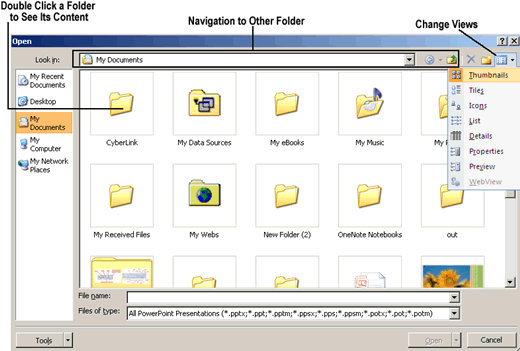Opening and Closing Presentations
To get to work on a presentation, you have to open it first. And, of course, you close a presentation when you are finished working on it and want to carry on normal activities. These pages explain all the intricate details of opening and closing presentations. In these pages, you will find many tips for finding and opening the presentation you want to work on.
Opening a Presentation
PowerPoint and Windows offer many shortcuts for opening presentations. To open a presentation, take the standard route - click the Office button and choose Open - or take advantage of the numerous ways to open presentations quickly.
The slow, conventional way to open a presentation
If you cannot open a file by any other means, you have to resort to the Open dialog box:
- Click the Office button and choose Open on the drop-down list (or press Ctrl+O). You see the Open dialog box.
- Locate and select the presentation you want to open and then click the Open button. Your presentation appears in
PowerPoint. You can also double-click a presentation name to open a presentation.

The Open dialog box offers a bunch of different ways to locate a presentation you want to open:
My Recent Documents Button: View presentations you recently worked on in the dialog box.
Look In drop-down List:
Look for folders or presentations on a different drive, network location, or disk (you can also click the My Computer button). Earlier in this tutorial, "Telling PowerPoint where you like to save presentations" explains how to make a folder of your choice appear first in the Look In drop-down list.
Back button:
Revisit folders you saw before in the course of your search.
Up One Level button:
Move up the folder hierarchy to show the contents of the folder one level above the one you are looking at.
Views drop-down List:
Display folder contents differently. In the Thumbnails view and Preview view, you can see the first slide in a presentation. Details view can be helpful when you have trouble finding a file. In Details view, you see how large files are and when they were last edited.
Folders:
Double-click a folder to see its contents in the Open dialog box.
If you know the first letter in the name of a presentation you want to open, type the letter in the File Name text box. Presentations whose names start with the letter you typed appear on the File Name drop-down list. Select a presentation and click the Open button.
Speed techniques for opening presentations
The fastest way to open a presentation is to click the Office button and click the presentation's name on the Recent Documents list. This list shows the names of the last nine presentations you opened. By moving the pointer over a name, you can see which folder it is stored in. Click the pin next to a name to make the name remain on the list even if it is not one of the last nine presentations you opened (click a second time to "unpin" a name).
To make more (or fewer) than nine presentation names appear on the Recent Documents list, click the Office button and choose PowerPoint Options. In the PowerPoint Options dialog box, click the Advanced category. Then enter a number in the Show This Number of Recent Documents box.
Deleting and renaming presentations in the Open dialog box
Deleting and renaming presentations are really the business of the Windows operating system, but you can delete and rename documents one at a time inside the Open dialog box. Within the Open dialog box, select the presentation that needs deleting or renaming and follow these instructions to delete or rename it:
Deleting a presentation:
Click the Delete button in the dialog box (or click the Tools button and choose Delete on the pop-up menu, or right-click and choose Delete). Then click Yes in the Confirm File Delete message box.
Renaming a presentation:
Click the Tools button and choose Rename on the pop-up menu (or right-click and choose Rename). Then type a new name.
Here are other speed techniques for opening presentations:
In Windows Explorer or My Computer:
Locate the presentation in one of these file-management programs and double-click its name. You can click the Start button and choose My Documents to open Windows Explorer to the My Documents folder.
Shortcut icon:
Create a shortcut icon to a presentation and place the icon on the Windows desktop. In Windows Explorer or the Open dialog box, right-click the presentation's name and choose Send To> Desktop (Create Shortcut). To quickly open the presentation, double-click its shortcut icon on the desktop.
Closing a presentation
Closing a presentation is certainly easier than opening one. To close a presentation, save your file and use one of these techniques:
- Click the Office button and choose Close on the drop-down list. The PowerPoint program remains open although the presentation is closed.
- Click the Close button, the X in the upper-right corner of the PowerPoint window (or press Alt+F4). Clicking the Close button closes PowerPoint as well as your presentation.
